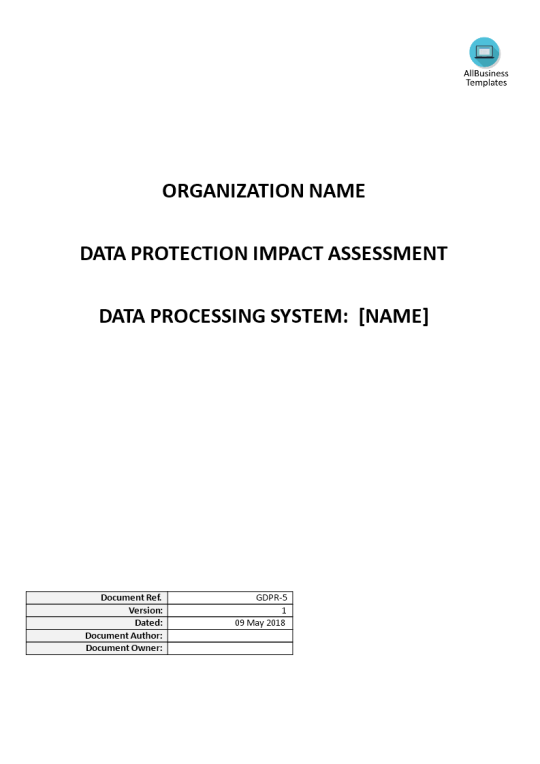#Data protection impact assessments (DPIAs)
Text
Data Protection: Legal Safeguards for Your Business
In today’s digital age, data is the lifeblood of most businesses. Customer information, financial records, and intellectual property – all this valuable data resides within your systems. However, with this digital wealth comes a significant responsibility: protecting it from unauthorized access, misuse, or loss. Data breaches can have devastating consequences, damaging your reputation, incurring…
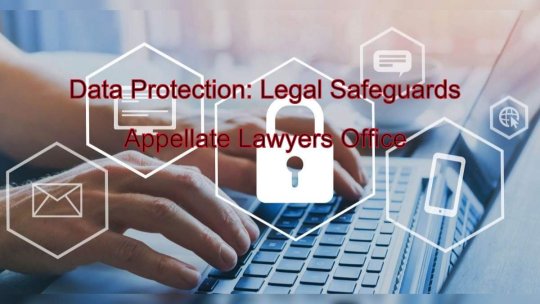
View On WordPress
#affordable data protection insurance options for small businesses#AI-powered tools for data breach detection and prevention#Are there any data protection exemptions for specific industries#Are there any government grants available to help businesses with data security compliance?#benefits of outsourcing data security compliance for startups#Can I be fined for non-compliance with data protection regulations#Can I outsource data security compliance tasks for my business#Can I use a cloud-based service for storing customer data securely#CCPA compliance for businesses offering loyalty programs with rewards#CCPA compliance for California businesses#cloud storage solutions with strong data residency guarantees#consumer data consent management for businesses#cost comparison of data encryption solutions for businesses#customer data consent management platform for e-commerce businesses#data anonymization techniques for businesses#data anonymization techniques for customer purchase history data#data breach compliance for businesses#data breach notification requirements for businesses#data encryption solutions for businesses#data protection impact assessment (DPIA) for businesses#data protection insurance for businesses#data residency requirements for businesses#data security best practices for businesses#Do I need a data privacy lawyer for my business#Do I need to train employees on data privacy practices#Does my California business need to comply with CCPA regulations#employee data privacy training for businesses#free data breach compliance checklist for small businesses#GDPR compliance for businesses processing employee data from the EU#GDPR compliance for international businesses
0 notes
Text
Article 22 of the General Data Protection Regulation (GDPR)- Automated Processing Decision
Article 22 of the General Data Protection Regulation (GDPR) deals with the right of individuals not to be subject to a decision based solely on automated processing, including profiling, which produces legal effects concerning them or similarly significantly affects them.
In other words, the GDPR prohibits organisations from making decisions about individuals’ data that are based solely on…

View On WordPress
#Automated decision-making#Children&039;s data protection#consent#Controller#Criminal offenses under data protection law#Cross-border data transfers#Data breach#Data minimization#Data portability#Data processor#Data protection authority#Data protection impact assessment (DPIA)#Data protection impact assessments (DPIAs)#Data protection officer (DPO)#Data protection principles#Data retention#Data sharing#Data subject#Data subject rights#Enforcement and penalties#Exemptions under the DPA 2018#GDPR: Personal data#Information Commissioner&039;s Office (ICO)#International data transfers#Lawful basis for processing#Personal data#Privacy by design#Privacy notice#Privacy policy#Processor
0 notes
Text
DPDPA Audit & Significant Data Fiduciaries
Imagine that a company in India, handling digital personal data, fails to comply with DPDPA rules due to its lack of transparent consent processes. So, unfortunately, they become exposed to legal consequences due to non-compliance and may even have to bear hefty fines of up to 250 Cr.
As an organisation, you want to steer clear of any non-compliance issue and an audit can be a lifesaver. It identifies and rectifies such vulnerabilities and protects the company's reputation and builds customer trust.
To put it simply, an audit is a proactive step to maintain data privacy, identify gaps, mitigate legal risks, and enhance your overall business integrity.
In this blog, we bring you everything you must know about DPDPA audits and significant data fiduciaries so you are on the safe side.
What Is The DPDPA Framework?
The DPDP Act 2023 brings us a comprehensive data protection law that's set to protect and safeguard personal data. It has far-reaching implications for businesses operating in the country.

DPDPA places various responsibilities on organisations that handle personal data to protect individuals' privacy and ensure responsible data management practices. This includes:
Getting free, specific, informed, unconditional, and unambiguous consent from individuals before collecting their personal data
Executing robust security safeguards to protect personal data from unauthorized access, accidental disclosure, acquisition, etc.
Granting individuals access to their data, as well as the right to correct, erase, or restrict its processing
In the unfortunate event of a data breach, organisations are obligated to notify the relevant authorities
It's also important to note that non-compliance with the DPDPA can result in penalties up to 250 cr.
Who Are Significant Data Fiduciaries?
In simple terms, a 'data fiduciary' under the DPDP is someone who, either alone or with others, decides why and how personal data is processed. This can include individuals, companies, associations, the government, or any other entity that controls personal data.

If the Central government identifies a data fiduciary or a group of them, they are called a Significant Data Fiduciary.
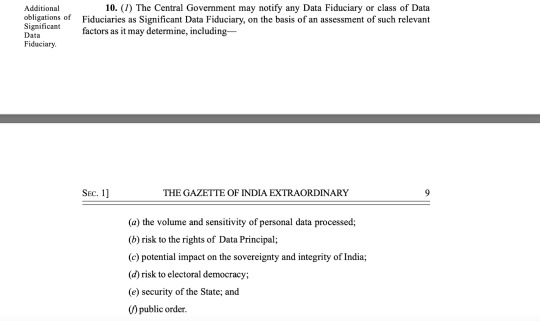
Source: Meity
This decision is based on several factors, including:
The volume and sensitivity of personal data processed
Risk to the rights of the Data Principal
Potential impact on the sovereignty and integrity of India
Risk to electoral democracy
Security of the State
Public order.
Additional Duties of Significant Data Fiduciaries
A Significant Data Fiduciary has additional responsibilities on top of Data Fiduciary duties. This includes:
Appointing a Data Protection Officer (DPO) - The DPO will represent the Significant Data Fiduciary under the provisions of the DPDP Act. However, they must be based in India. The DPO must also report to the Board of Directors or a similar governing body and be the point of contact for grievance redressal
Appointing an independent data auditor - The auditor evaluates the entity's compliance with the law
Conducting periodic Data Protection Impact Assessment (DPIA), which evaluates how personal data is processed, risks to individuals' rights, and other relevant details
Undertaking periodic audits to ensure ongoing compliance
Adopting additional measures as prescribed by law
Why Periodic DPDPA Audits Are Necessary?
A DPDPA audit falls under the additional responsibilities of a Significant Data Fiduciary.
It is mandatory for businesses in India to do a thorough DPDPA compliance audit. This audit can find any gaps in compliance and help take corrective measures to make sure they're following the law.
These audits can be incredibly beneficial, and here’s why you need them.
Regular DPDPA audits help you protect individuals' privacy in compliance with the law
It helps identify potential risks and vulnerabilities in data-handling processes
It lets you take proactive measures to mitigate risks before they become serious issues, such as hefty fines of up to 250 Cr
It helps you assess the effectiveness of existing security measures and identify areas for improvement to enhance overall data security. This, in turn, improves customer trust and brand image
It highlights any gaps or deficiencies in the organisation's data protection practices and offers insights into areas that may require additional attention or resources to prevent data breaches
DPDPA audits allow you to adapt to evolving threats and regulatory changes
Who Needs Regular DPDPA Audits?
It's quite simple. Audits are essential for all types of organisations and industries that handle personal data or have regulatory compliance requirements. However, as per the Digital Personal Data Protection Act, it's a mandate for Significant Data Fiduciaries, as discussed above.

This can include schools, colleges, and universities that handle student and staff information or healthcare providers who handle patients' medical records and sensitive health information. Regular audits ensure compliance, identify and address vulnerabilities, and maintain the security and integrity of the data they handle.
DPIAs and Audits: The Right Tool
Source: DPDP Consultants
Significant Data Fiduciaries are required to conduct DPIAs and regular audits. But this has to be done diligently. So, there is a need to automate the process to ensure all bases are covered while maximizing time and efficiency. These tools minimize human bias and produce a standardized report that streamlines the process.
That said, when it comes to DPIAs, you can switch to a Data Protection Impact Assessment Tool. It automates the entire DPIA process and lets you conduct the assessment almost effortlessly through a user-friendly platform.
With this tool, you can track risks that were identified during the assessment and make sure all concerned individuals are kept in the loop regarding the actions taken to mitigate these risks.
Let's make Compliance Easy
As per the DPDP Act, there are certain obligations you must adhere to when it comes to personal data. And, regular DPDPA audits and DPIAs are one of the duties of a Significant Data Fiduciary. DPIAs and audits help identify and rectify any potential breaches and ensure the lawful and secure processing of personal data.
They are almost indispensable for maintaining trust, avoiding penalties, and upholding a commitment to responsible data handling.
DPDP Consultants brings you a set of tools and services that makes compliance with the DPDP Act easy and streamlined:
Our Data Protection Consent Management tool streamlines the acquisition of valid consent and automates the entire process of managing, tracking, and handling consent requests
The Data Principal Grievance Redressal platform streamlines the process of exercising data rights through a user-friendly interface and improves response efficiency in accordance with the DPDP Act
Our Data Protection Impact Assessment tool aids in the easy assessment and tracking of risks and ensures transparent communication about risk mitigation efforts
Our Data Protection Awareness program allows management to oversee the ongoing and efficient execution of their personal data privacy initiatives
Our Contract Reviews and redrafting services ensure that your business's outsourcing agreements align with DPDPA compliance standards
Through our DPDP Data Protection Officer services, organisations can appoint a third party for process audits so it aligns seamlessly with DPDPA requirements
Our training program for employees caters to organisation-specific needs emphasizes the practical aspects of DPDPA compliance and covers personal data policies, processing activities, and more.
Compliance isn't just about following the law; it's also about building trust and keeping your brand's reputation strong. Treating personal data with care isn't just a legal requirement—it's key to making a digital society that's fair for everyone.
Simplify DPDPA Compliance And Optimise Your Operations!
DPDP Consultants offers comprehensive solutions for personal data privacy and privacy law guidance to ensure compliance.
#dpdp act#dpdp#dpdp act 2023#dpdpa tools#digital personal data protection#dpdpa#dpdp 2023#dpia#dpdp consultants#dpdp tool#DPDPA Audit
0 notes
Text
Short Guide to Conduct Effective DPIAs
Short Guide to Conduct Effective DPIAs
Data fuels innovation and drives business growth, so protecting privacy has become paramount.
With regulations like GDPR (General Data Protection Regulation) and the Data Protection Act in the UK, organizations are under increased scrutiny to safeguard personal data. One powerful tool in this effort is the Data Protection Impact Assessment (DPIA), a systematic process for evaluating and managing…

View On WordPress
#BusinessCompliance#BusinessDocuments#businessforms#ContractTemplates#data#dataprotection#DataProtectionAct#DPIAProcess#gdpr#GDPRUK#LawDocuments#LegalDocuments#LegalForms#lexdexsolutions#privacycompliance#PrivacyData#PrivacyRiskManagement#TemplateOfAgreement#UKPrivacy#privacy
0 notes
Link
0 notes
Text
What is the process for obtaining GDPR Certification?

GDPR Certification in Canada
GDPR Certification in Canada Often, Canadian businesses interact with the European Union (EU) directly or indirectly. As a result, Canadian companies must address how they can ensure compliance with the General Data Protection Regulation (GDPR), even if they don’t explicitly target EU citizens. Although Canada has no official GDPR Certification, demonstrating compliance can provide significant benefits. You can show your commitment to data protection in Canada by obtaining GDPR Certification. GDPR Certification in Canada and explore the pathways to demonstrating your commitment to data protection.
The GDPR Certification Process in Canada
Before diving into certification, it’s essential to understand the scope of GDPR. This regulation applies to any organization processing the personal data of EU citizens, regardless of the organization’s location. So, even if your business is solely based in Canada, if you collect or process data from EU residents, GDPR compliance becomes mandatory.
What are the benefits of GDPR certification in Canada?
GDPR compliance extends beyond legal obligations. It fosters trust with clients, enhances data security, and mitigates risk. Here are some compelling reasons for Canadian businesses to pursue GDPR compliance:
Strengthening Business Relationships: Demonstrating GDPR compliance showcases your commitment to data protection, potentially boosting trust and maintaining relationships with EU clients and partners.
Building Consumer Confidence: Consumers increasingly value data privacy. Compliance signifies your respect for individual rights and strengthens your brand reputation.
Minimizing Risk: Data breaches can incur hefty fines under GDPR. Embedding GDPR principles reduces the risk of such incidents and associated penalties.
Aligning with Canadian Data Laws: GDPR principles closely align with Canada’s Personal Information Protection and Electronic Documents Act (PIPEDA). Compliance with GDPR can simplify adherence to both regulations.
Here are the steps to GDPR certification in Canada:
While there’s no official certification, demonstrating GDPR compliance involves specific steps:
Conducting a Data Inventory: Identify and map all personal data you collect and process, assessing its origin, purpose, and storage location.
Implementing Data Protection Policies: Develop comprehensive policies outlining data collection, storage, access, and security measures.
Appointing a Data Protection Officer (DPO) (if applicable): For organizations with 250 or more employees or whose core activities involve large-scale personal data processing, appointing a DPO is mandatory.
Performing Data Protection Impact Assessments (DPIAs): Assess the potential risks and impact of data processing activities on individual privacy.
Establishing Data Subject Rights Procedures: Implement processes for handling data subject rights requests, such as access, rectification, and erasure.
Implementing Breach Notification Procedures: Develop a protocol for promptly identifying, reporting, and managing data breaches.
Ongoing Monitoring and Maintenance: Regularly review and update your GDPR compliance program to ensure effectiveness and adapt to evolving regulations
Conclusion:
While GDPR compliance might seem daunting for Canadian businesses, its benefits outweigh the challenges. By taking a proactive approach to data protection, you can build trust, mitigate risk, and ultimately thrive in the global marketplace. Remember, the journey toward GDPR compliance is an investment in your company’s future and a demonstration of your commitment to responsible data handling. GDPR Certification in Jordan
The Benefits of Factocert’s GDPR Certification in Canada
We provide the best GDPR Certification in Canada, are knowledgeable, and provide the best solutions. And how to get ISO certification in Canada. Kindly reach us at [email protected]. GDPR Consultants in Canada work according to GDPR standards and help organizations implement GDPR Certification with proper documentation.
For more information, visit GDPR Certification in Canada.
Related Links:
· GDP Certification in Canada
· GLP Certification in Canada
· GMP Certification in Canada
· GDPR Certification in Canada
· SOC 1 Certification in Canada
· SOC 2 Certification in Canada
· SA 8000 Certification in Canada
· RoHS Certification in Canada
RELATED ARTICLE
GDPR Consultants in Canada
0 notes
Text
Schedule Your GDPR Compliance Audit Now

General Data Protection Regulation (GDPR) governs how EU organizations collect and use personal data. The GDPR applies to EU companies and those handling EU residents’ data.
GDPR compliance can be difficult. Users have data privacy rights and data processing principles under the law. GDPR requires companies to uphold these rights and principles, but it gives them some leeway.
For noncompliance, the GDPR imposes severe penalties. The worst violations can result in fines of EUR 20,000,000 or 4% of the company’s global turnover from the previous year. Additionally, General Data Protection Regulation regulators can stop illegal data processing and force organizations to change.
The following checklist covers General Data Protection Regulation essentials. How a company complies with these regulations depends on its data collection and use.
GDPR fundamentals
European Economic Area organizations must comply with GDPR. All 27 EU countries plus Iceland, Liechtenstein, and Norway are EEA members.
A non-EEA organization is subject to GDPR if:
EEA residents receive goods and services from the company without payment.
With cookies, the company tracks EEA residents’ activity.
Data is processed for an EEA company.
The GDPR cover more than commercial use of customer data. Just about any organization that handles EEA residents’ data is affected. GDPR covers schools, hospitals, and government agencies.
Only national security or law enforcement activities and personal data processing are exempt from General Data Protection Regulation.
Effective GDPR definitions
GDPR terminology is specific. Understanding these terms in this context helps organizations understand compliance requirements.
According to the General Data Protection Regulation, personal data is any information about an identifiable person. Email addresses and political views are personal data.
The data owner is the data subject. Data refers to a person. Imagine a company collecting phone numbers for SMS marketing. Individuals with those phone numbers are data subjects.
Data subjects in the GDPR are EEA residents. General Data Protection Regulationdata privacy rights are not limited to EU citizens. They need only EEA residency.
The person, group, or organization that collects and uses personal data is a data controller. For example, a marketing company collecting phone numbers is a controller.
Processing data includes collecting, storing, and analyzing it. Organizations or actors that perform such actions are data processors.
A company that collects phone numbers and sends marketing messages is a controller and processor. One example of a processor is a cloud storage service that hosts a phone number database for another business.
Supervision authorities enforce General Data Protection Regulation. All EEA countries have supervisory authorities.
Is a GDPR audit required?
Audits are not required, but they are strongly advised in order to:
Find and proactively close compliance gaps.
Give regulators and data subjects your best effort.
Reduce the possibility of penalties and reputational harm.
Which kinds of audits exist?
Various kinds consist of:
Either your own employees or outside consultants can conduct internal audits.
Third-party audits are unbiased assessments carried out by qualified auditors.
Assessments of the data protection impact (DPIAs) are necessary for processing operations with a high level of risk.
Ways to prepare for the audit?
Maintain easy access to your processing records, data inventory, and privacy policy.
Keep a record of your training materials and procedures for notifying data breaches.
Assure users have access to pertinent IT systems and records.
Audit Procedure and Scope:
How will the auditors evaluate it?
Usually, they’ll concentrate on:
Locating, managing, and identifying personal data: Data mapping and inventory.
Justification for processing legally: Whether processing data is justified in your case.
Individual rights: How you respond to requests from data subjects and guarantee their control.
Applying suitable organizational and technical safeguards is data security.
Governance and processes include incident response plans, training, and data protection laws.
Which steps are part of the auditing process?
Scoping and planning: Defining the focus areas and objectives of the audit.
Information gathering Includes conducting interviews and going over records and policies.
Analyzing and testing: Finding weaknesses and assessing controls.
Reporting and suggestions: Putting together a report that includes conclusions and remedial measures.
Following an GDPR audit:
How should I respond to the audit results?
Create and carry out an action plan to close any gaps and shortcomings found.
Do I have to tell anyone about the results?
Serious non-compliance may need to be reported to regulators if the audit finds it.
How often should my GDPR audits be carried out?
To guarantee continued compliance, it is advised to conduct audits on a regular basis, preferably every 12 to 24 months.
Extra Advice
Include important parties: Ensure that the audit process involves the participation of pertinent departments and personnel.
Continue to communicate clearly: Make sure that everyone is aware of their responsibilities and the audit’s goals.
Make the most of the audit as a teaching tool: Consider the audit as an opportunity to enhance your data security procedures.
Read more on Govindhtech.com
0 notes
Text
Data Security in Insolvency: Safeguarding Digital Assets During Liquidation
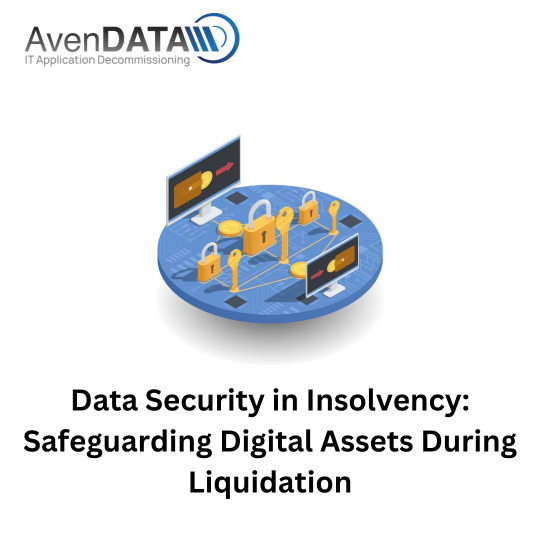
Introduction:
In an era where digital assets form the backbone of organizational operations, the intersection of insolvency and data security becomes a critical juncture demanding specialized attention. As companies navigate the turbulent waters of liquidation, safeguarding digital assets takes center stage to protect sensitive information, maintain regulatory compliance, and uphold the trust of stakeholders. In this blog, we delve into the intricate landscape of "Data Security in Insolvency," unveiling strategies to be the guardians of digital fortunes during the liquidation process.
The Digital Dilemma: Data Vulnerabilities in Insolvency
1.Understanding the Risk Landscape: Mapping Digital Vulnerabilities
Begin by illuminating the unique risk landscape organizations face during insolvency, identifying digital vulnerabilities that could expose sensitive data to potential breaches.
2.Cybersecurity Threats in the Wake of Financial Distress: A Closer Look
Explore the heightened cybersecurity threats that arise in the wake of financial distress, examining how insolvency can attract malicious actors seeking to exploit vulnerabilities.
Crafting a Robust Data Security Framework
1.Tailored Data Classification: Customizing Security Measures for Digital Assets
Discuss the importance of data classification tailored to the specifics of digital assets, ensuring that security measures are customized based on the sensitivity and criticality of each data type.
2.Encryption Protocols: Fortifying Digital Assets Against Unauthorized Access
Delve into the significance of encryption protocols in fortifying digital assets, elucidating how robust encryption methods act as a formidable barrier against unauthorized access during insolvency.
Navigating Regulatory Compliance
1.GDPR, HIPAA, and More: Ensuring Compliance Amid Financial Turmoil
Provide insights into navigating complex regulatory landscapes during insolvency, emphasizing the need for continued compliance with data protection regulations such as GDPR and HIPAA.
2.The Role of Data Protection Impact Assessments (DPIAs) in Insolvency
Explore the role of Data Protection Impact Assessments (DPIAs) in the context of insolvency, guiding organizations on conducting thorough assessments to identify and mitigate data security risks.
Employee Awareness and Training
1.Building a Cyber-Resilient Culture: Employee Training Initiatives
Discuss the crucial role of employee awareness and training programs in building a cyber-resilient culture, ensuring that the human factor becomes an asset rather than a vulnerability.
2.Insider Threat Mitigation: Strategies for Identifying and Addressing Risks
Address the nuanced challenge of insider threats during insolvency, providing strategies for identifying and mitigating risks associated with employees or third parties with insider access.
Secure Data Destruction Protocols
1.Beyond Deletion: Implementing Secure Data Destruction Protocols
Unveil the importance of secure data destruction protocols beyond standard deletion methods, emphasizing secure erasure techniques to prevent data remnants from falling into the wrong hands.
2.Third-Party Vetting: Ensuring Security in Digital Asset Disposal
Explore the significance of thoroughly vetting third-party service providers involved in digital asset disposal, ensuring that they adhere to stringent security standards and protocols.
Continuous Monitoring and Incident Response
1.Real-time Monitoring: Staying Vigilant in the Face of Emerging Threats
Highlight the necessity of real-time monitoring systems for digital assets, allowing organizations to stay vigilant and respond promptly to emerging cybersecurity threats.
2.Incident Response Playbooks: Ready for Action in the Event of a Breach
Discuss the importance of incident response playbooks, providing organizations with a structured guide on how to act swiftly and effectively in the event of a data security breach.
Conclusion: The Sentinel’s Legacy
In the realm of insolvency, the role of the sentinel is bestowed upon those entrusted with safeguarding digital assets. By understanding the unique challenges, implementing robust security frameworks, and embracing a culture of cyber-resilience, organizations can navigate the complexities of liquidation while upholding the sanctity of their digital fortunes. As guardians of digital legacies, they ensure that even in the face of financial distress, the beacon of data security remains unwavering.
0 notes
Text
How to Create a Record of Processing Activities (ROPA)

Creating and maintaining a Record of Processing Activities (ROPA) is a crucial requirement under the UK GDPR for most organizations processing personal data. Even though organizations with less than 250 employees have some flexibility in creating a ROPA, it is considered best practice for all organizations to have one in place to ensure GDPR compliance.
A ROPA serves as a central document for data protection compliance and is valuable for identifying data risks and informing Data Protection Impact Assessments (DPIAs).
Here is a step-by-step procedure on how to create a ROPA:
Understand the Benefits:
Demonstrates compliance with the UK GDPR's accountability principle.
Provides evidence of compliance during investigations by the Information Commissioner's Office (ICO).
Facilitates data discovery and identifies unnecessary data collection, ensuring compliance with the purpose limitation principle.
Enables validation of acquired data and removal of superfluous personal data, aligning with the data minimization principle.
Supports compliance with other aspects of data protection law, such as creating privacy notices and enforcing retention schedules.
Enhances information governance practices and improves data management.
Helps identify and address data duplications and divergences, improving data accuracy and reliability.
Data Discovery:
Identify and document all processing activities involving personal data within the organization.
Determine the purposes of data processing, categories of data subjects, categories of personal data, recipients of data, and data transfers.
Document Information:
Create a structured format for the ROPA, including relevant sections and fields for capturing necessary information.
Record details such as data processing activities, purposes, lawful basis, data retention periods, and any additional relevant information.
Collaborate with Stakeholders:
Engage with relevant stakeholders, including departments or teams involved in data processing activities.
Seek input and feedback to ensure comprehensive coverage of processing activities and accurate documentation.
Regularly Review and Update:
Establish a process for regularly reviewing and updating the ROPA to reflect any changes in data processing activities.
Ensure the ROPA remains accurate, up-to-date, and aligned with the organization's privacy compliance framework.
Maintain Compliance:
Ensure the ROPA is readily accessible and available for inspection by the ICO upon request.
Leverage the information in the ROPA to inform DPIAs and other compliance activities.
Creating a ROPA not only helps organizations meet their legal obligations but also improves data governance, minimizes risks, and enhances overall data protection practices.
Please note that this summary provides a high-level overview, and it is recommended to refer to official guidance, such as that provided by the ICO, for more detailed instructions on creating a ROPA.
Creating a ROPA
The suggested procedure you provided outlines practical steps for creating a ROPA. Here's a summary of the procedure:
Appoint and train privacy champions: For larger organizations, appoint individuals as privacy champions to work with the data protection lead in creating the ROPA. Privacy champions should have a good understanding of their department's operations and be responsible for data protection compliance within their respective departments.
Identify all processing activities: Focus on processing activities involving personal data and categorize them based on business departments or functions within the organization. The data protection lead, along with privacy champions, may need to engage with department heads and process owners to gather comprehensive information on processing activities.
Answer key questions: Ensure the ROPA addresses key questions about personal data processing, including:
Categories of personal data being processed
Data subjects involved and responsible process owners
Recipients of data, including any transfers outside the UK or EEA
Purpose of processing and lawful grounds
Data storage locations
Data retention periods
Data protection measures and safeguards
Record the information: Keep the ROPA in an easily accessible electronic format. The ICO provides a template that can be adapted to suit the organization's specific requirements.
Keep it up to date: The ROPA should be regularly reviewed and updated to reflect changes in processing activities and comply with evolving data privacy regulations. Conduct quarterly reviews and consider triggers such as new requirements, IT applications, planned processing activities, changes in data processors, mergers or acquisitions, and clarifications of privacy laws. Ensure data protection is an ongoing agenda item in team meetings.
Creating and maintaining an up-to-date ROPA demonstrates accountability, helps identify unnecessary data collection, facilitates compliance with data protection principles, and improves overall information governance practices.
If you need assistance with creating or developing your ROPA, you can reach out to one of URM’s GDPR consultants or complete an enquiry form on their website.
Please note that the provided summary is based on the information you shared, and it's advisable to refer to official guidance and consult with legal professionals to ensure compliance with specific regulatory requirements and organizational needs.
0 notes
Text
Data Privacy and GDPR Compliance

The General Data Protection Regulation (GDPR) is a comprehensive data protection regulation that sets the standard for privacy and data protection practices. Let’s explore the importance of data privacy and the key aspects of GDPR compliance.
Why Data Privacy Matters
Data privacy is crucial for several reasons:
Protecting Personal Information: Data privacy ensures the protection of individuals’ personal information, such as names, addresses, financial data, and other sensitive details. It helps prevent unauthorized access, misuse, and potential harm to individuals.
Building Trust: Organizations that prioritize data privacy foster trust among their customers, employees, and stakeholders. By demonstrating a commitment to protecting personal information, organizations enhance their reputation and maintain strong relationships with their stakeholders.
Complying with Regulations: Adhering to data privacy regulations, such as GDPR, is not only ethical but also a legal requirement in many jurisdictions. Failure to comply with regulations can result in severe penalties, damage to reputation, and legal consequences.
Understanding GDPR
The GDPR is a comprehensive data protection regulation enforced by the European Union (EU). It applies to organizations that process the personal data of EU residents, regardless of the organization’s location. Here are key aspects of GDPR compliance:
Lawful Basis for Data Processing: GDPR requires organizations to have a lawful basis for processing personal data. This includes obtaining consent, fulfilling contractual obligations, legal compliance, protecting vital interests, performing a task in the public interest, or legitimate interests pursued by the organization.
Transparency and Consent: Organizations must be transparent about how they collect, use, and process personal data. They need to provide clear privacy notices, obtain explicit consent for data processing, and allow individuals to easily withdraw their consent if desired.
Individual Rights: GDPR grants individuals various rights over their personal data. These rights include the right to access, rectify, erase, restrict processing, data portability, and object to processing. Organizations must provide mechanisms to fulfill these rights within specified timeframes.
Data Protection Impact Assessments (DPIA): Organizations must conduct DPIAs for high-risk data processing activities. A DPIA assesses the potential impact on individuals’ privacy and helps identify and mitigate risks.
Data Breach Notification: GDPR mandates organizations to report certain types of personal data breaches to the appropriate supervisory authority within 72 hours of becoming aware of the breach. Individuals affected by the breach must also be notified without undue delay if the breach poses a high risk to their rights and freedoms.
Appointment of Data Protection Officer (DPO): Some organizations must appoint a Data Protection Officer to oversee GDPR compliance, provide guidance, and act as a point of contact for individuals and supervisory authorities.
Achieving GDPR Compliance
To achieve GDPR compliance, organizations should consider the following steps:
Conduct a Data Inventory: Identify and document the personal data your organization processes, where it comes from, how it is stored, and who has access to it.
Review Data Processing Activities: Assess the legal basis for processing personal data and ensure that processing activities align with GDPR requirements.
Implement Security Measures: Implement appropriate technical and organizational measures to ensure the security of personal data. This may include access controls, encryption, pseudonymization, regular security assessments, and staff training.
Review Consent Mechanisms: Review and update consent mechanisms to ensure they meet GDPR standards. Obtain explicit and freely given consent where required.
Establish Data Subject Rights Processes: Develop procedures to handle data subject requests, such as requests for access, rectification, erasure, or data portability.
Implement Data Breach Response Plan: Develop a data breach response plan to detect, respond to, and report data breaches as required by GDPR.
Train Employees: Provide training to employees on data protection principles, GDPR requirements, and their responsibilities in ensuring compliance.
Review and Update Policies and Procedures: Regularly review and update your organization’s privacy policies, procedures, and contracts to align with GDPR requirements.
It is important to note that achieving and maintaining GDPR compliance is an ongoing process. Organizations must regularly assess their data privacy practices, adapt to regulatory changes, and continuously improve their data protection measures.
If you need guidance on GDPR compliance and data privacy, visit us at www.infradapt.com or call us at 484-546-2000. Our team of experts can provide insights and solutions to help your organization navigate the complexities of data privacy regulations and ensure compliance with GDPR.
https://www.infradapt.com/news/data-privacy-and-gdpr-compliance/
0 notes
Text
4 DPDPA Tools You Need To Get Compliant
4 DPDPA Tools You Need To Get Compliant
The Digital Personal Data Protection Act, 2023, highlights the significance of protecting personal data in the digital age and makes substantial modifications to India's data protection laws. With these new regulations come obligations for businesses to ensure compliance and protect the privacy and security of Indian citizens' personal data.
In this blog, we'll explore four essential DPDPA tools that can assist your organisation in achieving compliance:
Consent Management Platform
Grievance Redressal System
Assessments and Audits Tool
DPDP Act Awareness Program

Digital Personal Data Protection Act (DPDPA) Compliance Checklist
To ensure that your organisation complies with the Digital Personal Data Protection Act, 2023, take the following steps:
1. Obtain explicit consent
Prior to processing, collecting, using, or sharing personal information, ensure explicit consent is obtained from data principals.
2. Issue Retroactive Consent Notices
Provide retroactive consent notices for any consents obtained before the enactment of the law to ensure transparency and compliance.
3. Manage Data Principal Requests
Respond promptly to data principals' requests to access, correct, update, or remove their personal data to uphold their rights.
4. Conduct Periodic DPIAs
Conduct Data Protection Impact Assessments regularly to assess and manage risks associated with personal data processing.
5. Create DPDP Training Program For Employees
Establish a comprehensive training program to educate and empower employees about their responsibilities under the Data Protection and Privacy Act (DPDPA), reducing the likelihood of non-compliance.
6. Appoint Independent Auditor & DPOs
Appoint independent auditors and dedicated Data Protection Officers (DPOs) to oversee compliance efforts and ensure accountability within the organisation.
These are the basics of building compliance with the Digital Personal Data Protection Act, by doing so, organisations can uphold the data processing hygiene that the DPDPA law mandates.

Tools to Build Digital Personal Data Protection Act (DPDPA) Compliance For Companies
With data privacy regulations becoming increasingly stringent, it's essential for businesses to ensure compliance to protect the personal information of individuals. Let's explore four DPDPA tools and how they can help your organisation build compliance:
1. Consent Management Tool
Getting the data principals' explicit consent is required under DPDPA Section 6. It is necessary to take explicit affirmative action in order for this consent to be freely granted, specific, informed, unconditional, and unambiguous. It should be clear about the data used and the purpose for which the individual has granted consent.

Source: Meity.gov
Notice: A notice must also be sent along with the consent detailing the nature of the personal data, the reason for processing it, the rights of the data principal, and how they may exercise those rights. These notices should be written in plain, easy-to-read language and must include a link to see the notice in any of the languages listed in the Eighth Schedule of the Constitution in addition to English.
Problem: Managing consent requests manually is not only challenging but also prone to manual error leaving gaps in your organisations compliance building efforts.
Solution: An automated Consent Management tool can be used to manage, monitor, and track consent requests.
2. Data Principal Grievance Redressal Platform
Under Section 12 of the DPDPA, data principals have the right to access, update, or delete their personal data. To avoid penalties that go up to INR 250cr, companies need to respond to these requests in a reasonable time frame.

Problem: To fast-track and resolve these data principal requests in time and also have tangible proof as evidence if needed.
Solution: An automated grievance redressal tool enables data principals to assert their rights via a user-friendly platform, managed by DPOs and stakeholders.
3. Automated Data Protection Impact Assessments (DPIAs)
Under the DPDP Act, appointing a Data Protection Officer (DPO) as the central point of contact for all aspects of the act is essential for your role as a Significant Data Fiduciary. The DPOs must conduct periodic Data Protection Impact Assessments (DPIAs) to evaluate and mitigate risks to ensure compliance.

Source: Freepik
A Data Protection Impact Assessment is a structured process created to assist in systematically analyzing, identifying, and minimizing risks related to data protection.
Problem: Small and medium-sized businesses (SMEs) can benefit from using built-in templates, but bigger organisations and Significant Data Fiduciaries (SDFs) need a more reliable and scalable solution to handle the significant processing and gathering of personal data.
Solution: The Data Protection Impact Assessment (DPIA) Tool enables Data Protection Officers (DPOs) to conduct DPIAs, track identified risks, and ensure compliance with regulatory requirements by providing a user-friendly platform.

Source: Freepik
4. DPDP Act Employee Training & Awareness
Under the Digital Personal Data Protection Act 2023, all employees handling personal data on behalf of organisations must understand their responsibilities under the law and also ways to tackle breach in emergencies.
Solution: DPDP Consultants’ Data Protection Awareness Program (DPAP) is a subscription-based DPDPA tool that enables companies to conduct regular and mandatory awareness sessions, followed by assessments.
By fostering a culture of compliance within your organisation, you can minimize the risk of non-compliance and build trust with customers and stakeholders.
Conclusion
Achieving compliance with the Data Privacy and Protection Act (DPDPA) is crucial for businesses operating in today's digital landscape. The four DPDPA tools discussed in this blog offer indispensable support in navigating the complexities of data privacy and protection regulations. These tools empower organisations to handle their data privacy requirements efficiently and automate manual tasks that are prone to error.
By implementing these tools, businesses can streamline their compliance efforts, and foster trust with their customers by demonstrating a commitment to protecting their sensitive information. Investing in robust DPDPA tools is becoming exceedingly necessary as the regulatory environment changes to maintain long-term compliance and protect the integrity of your company's data operations.
Embracing these tools not only helps businesses meet regulatory requirements but also positions them for success in an increasingly data-driven world.
Ready To Automate DPDPA compliance?
Contact DPDP Consultants today to learn more about our innovative tools and services to help secure and make your business DPDP Compliant today.
#dpdp act#dpdp act 2023#dpdp#dpdpa tools#dpia#digital personal data protection#dpdp 2023#dpdp consultants#dpdp tool#dpdpa
0 notes
Text
How Can SMEs in the UK Implement Data Protection Impact Assessment (DPIA) Procedures?
Small and medium-sized enterprises (SMEs) in the UK face unique challenges when it comes to navigating data protection regulations. However, implementing Data Protection Impact Assessment (DPIA) procedures can be a transformative step for these businesses. In this post, we’ll delve into the significant benefits DPIA procedures offer to SMEs, the specific problems they can solve, and how they can…
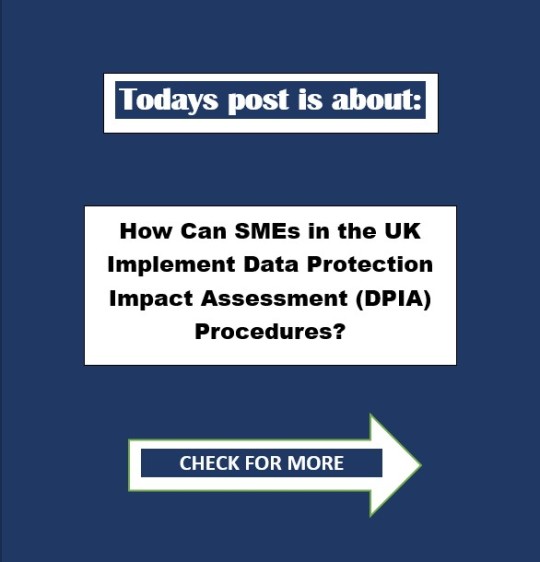
View On WordPress
#BusinessStrategy#ComplianceMadeEasy#CustomerTrust#Cybersecurity#DataGovernance#DataManagement#dataprivacy#dataprotection#DataProtectionImpactAssessment#datasecurity#DigitalTransformation#dpia#gdpr#LegalCompliance#privacycompliance#RegulatoryCompliance#RiskManagement#SMEs#TrustBuilding#UKBusiness#smallbusiness
0 notes
Text
data protection impact assessment (DPIA)
http://i.securitythinkingcap.com/Ss4qXJ
0 notes
Text
How can I get GDPR Certification?
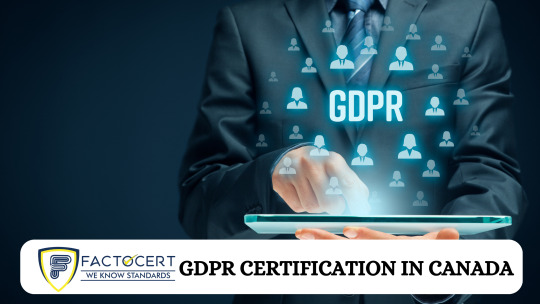
GDPR Certification in Canada
GDPR Certification in Canada businesses operating in Canada often touch the European Union (EU) market, either directly or indirectly. This raises a crucial question: how can Canadian companies ensure compliance with the EU’s General Data Protection Regulation (GDPR), even if they’re not explicitly targeting EU citizens? While there’s no official GDPR Certification in Canada per se, achieving demonstrable compliance can provide significant advantages. Let’s delve into the intricacies of GDPR Certification in Canada and explore the pathways to demonstrating your commitment to data protection.
The GDPR Certification Process in Canada
Before diving into certification, it’s essential to understand the scope of GDPR. This regulation applies to any organization processing the personal data of EU citizens, regardless of the organization’s location. So, even if your business is solely based in Canada if you collect or process data from EU residents, GDPR compliance becomes mandatory.
What are the benefits of GDPR certification in Canada?
GDPR compliance extends beyond legal obligations. It fosters trust with clients, enhances data security, and mitigates risk. Here are some compelling reasons for Canadian businesses to pursue GDPR compliance:
Strengthening Business Relationships: Demonstrating GDPR compliance showcases your commitment to data protection, potentially boosting trust and strengthening relationships with EU clients and partners.
Building Consumer Confidence: Consumers increasingly value data privacy. Compliance signifies your respect for individual rights and strengthens your brand reputation.
Minimizing Risk: Data breaches can incur hefty fines under GDPR. Embedding GDPR principles reduces the risk of such incidents and associated penalties.
Aligning with Canadian Data Laws: GDPR principles closely align with Canada’s Personal Information Protection and Electronic Documents Act (PIPEDA). Compliance with GDPR can simplify adherence to both regulations.
Here are the steps to GDPR certification in Canada:
While there’s no official certification, demonstrating GDPR compliance involves specific steps:
Conducting a Data Inventory: Identify and map all personal data you collect and process, assessing its origin, purpose, and storage location.
Implementing Data Protection Policies: Develop comprehensive policies outlining data collection, storage, access, and security measures.
Appointing a Data Protection Officer (DPO) (if applicable): For organizations with 250 or more employees or whose core activities involve large-scale personal data processing, appointing a DPO is mandatory.
Performing Data Protection Impact Assessments (DPIAs): Assess the potential risks and impact of data processing activities on individual privacy.
Establishing Data Subject Rights Procedures: Implement processes for handling data subject rights requests, such as access, rectification, and erasure.
Implementing Breach Notification Procedures: Develop a protocol for identifying, reporting, and managing data breaches promptly.
Ongoing Monitoring and Maintenance: Regularly review and update your GDPR compliance program to ensure effectiveness and adapt to evolving regulations
Conclusion:
While GDPR compliance might seem daunting for Canadian businesses, its benefits outweigh the challenges. By taking a proactive approach to data protection, you can build trust, mitigate risk, and ultimately thrive in the global marketplace. Remember, the journey toward GDPR compliance is an investment in your company’s future and a demonstration of your commitment to responsible data handling. GDPR Certification in Jordan
The Benefits of Factocert’s GDPR Certification in Canada
We provide the best GDPR Certification in Canada, are knowledgeable, and provide the best solutions. And how to get ISO certification in Canada. Kindly reach us at [email protected]. GDPR Consultants in Canada work according to GDPR standards and help organizations implement GDPR Certification with proper documentation.
For more information, visit GDPR Certification in Canada.\
Related Links:
· GDP Certification in Canada
· GLP Certification in Canada
· GMP Certification in Canada
· GDPR Certification in Canada
· SOC 1 Certification in Canada
· SOC 2 Certification in Canada
· SA 8000 Certification in Canada
· RoHS Certification in Canada
RELATED ARTICLE
GDPR Consultants in Canada
0 notes
Text
New UK Privacy Team service opportunities – Privacy Team Coordinator, Privacy Contact Person, and Data Protection Officer
Are you inspired to serve the UK Vipassana Trusts and contribute to the spread of the teachings of Dhamma? Do you have a genuine enthusiasm for protecting personal data? Are you driven to ensure the Trusts’ compliance with UK GDPR and relevant data protection laws, safeguarding them against potential legal complications? Whether you already possess expertise in UK/EU GDPR and data protection laws or are eager to learn, we will welcome your application.
We have three opportunities for meditators to support the work of the UK Vipassana Trusts – Dhamma Dīpa, Dhamma Padhāna and Dhamma Sukhakāri. We are currently seeking candidates for the roles of Privacy Team Coordinator, Privacy Contact Person and Data Protection Officer, who together will help ensure the Trusts’ compliance with data protection laws and regulations.
While prior experience of serving the Trusts in any capacity, such as a course or service-period server or as a committee member is desirable, it is not essential. If necessary, formal training can be provided for the technical roles, and our dedicated Privacy Team will also provide assistance and support to bridge any knowledge gaps.
Privacy Team Coordinator
This role is key to keeping the team organised and the compliance programme moving forward. It’s suited to someone with a project management or administrator background. No knowledge of the data protection discipline is necessary, although prior experience in this area is an advantage.
Essential skills needed are:
1. Ability to organise a remote team and keep them on track with regular meetings and updates.
2. Good project and task management skills.
3. Good communication skills, to facilitate planning and maintaining a schedule of work in collaboration with the team.
4. Ability to summarise compliance programme status and report progress.
5. Proficiency in maintaining online documentation and records.
6. Comfortable with exploiting online collaboration tool capabilities to improve processes and team efficiency.
7. A good working knowledge of English, as meetings and documentation will be in English.
Privacy Contact Person
This role is more closely involved with the meditation centre’s data protection practices and works closely with the Data Protection Officer to ensure that the centre’s data processing is compliant.
Essential skills needed are:
1. Confidence to learn new technical knowledge if not already familiar with the data protection field.
2. Ability to share technical knowledge of data protection with others in an accessible manner.
3. Ability to discover and document organisational processes and data processing activities, working effectively with volunteers at all levels.
4. 4Methodical approach to conducting audits and documenting information.
5. Excellent communication and interpersonal skills to effectively advise and assist in training staff and volunteers on data protection matters and to communicate with data subjects.
6. Comfortable with attending and reporting progress to the Trustees at Trust meetings.
7. Comfortable with using online collaboration tools and proficient in maintaining online documentation and records.
8. A good working knowledge of English, as meetings and documentation will be in English.
Data Protection Officer
As an independent advisor, you will inform and advise the Trusts on their data protection obligations. Your responsibilities will include monitoring internal compliance, providing guidance on Data Protection Impact Assessments (DPIAs), working closely with the UK Privacy Team and acting as a point of contact for data subjects and the Information Commissioner’s Office (ICO).
This role may suit individuals with backgrounds in audit, compliance, information management, risk management or even a legal profession, even if they lack previous Data Protection experience.
The role requires a combination of technical knowledge, communication skills and attention to detail. Whilst the technical knowledge can be learnt, these essential skills are required
1. Ability to interpret and apply data protection requirements to organisational processes and activities.
2. Excellent communication and interpersonal skills to effectively advise and train staff and volunteers on data protection matters.
3. Strong analytical and problem-solving skills to identify and mitigate data protection risks.
4. Attention to detail and accuracy in conducting audits and assessments.
5. Ability to work independently and manage multiple tasks within deadlines.
6. Proficiency in maintaining documentation and records related to data protection activities.
7. A good working knowledge of English, as meetings and documentation will be in English.
These three roles will be vital in ensuring the Trusts’ compliance with data protection laws and maintaining the privacy and trust of individuals who sit and serve on courses.
They are volunteer positions, but they could be a good opportunity to gain experience in the field of data protection.
For all these posts, online collaboration tools will be provided. Experience of the Microsoft 365 toolset will be an advantage, but training can be given where needed. Most of the work can be done online from any location, although in some cases attendance at the Hereford meditation centre may be needed at times.
The workload will require regular input and teamwork to ensure the progression of compliance work, although time away for sitting courses and holidays can be accommodated within the team structure. Although the roles will require regular input, there will also be peaks and troughs of activity levels. Our experience shows that a few hours per week is adequate in normal circumstances.
If you are interested in any of these opportunities, please email [email protected] with a brief description of the skills and experience you believe you can bring to any of these roles. We look forward to receiving your application.
0 notes
